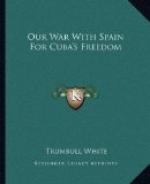Cavalry charges.
The Cubans are among the most skillful and daring rough riders of the world, the equals of the cowboys of our western States, and the far-famed Cossacks of Russia. The horses’ backs have been their cradles, and here they possess a decided advantage over their Spanish foes, who know as little of the equestrian art as they seem to understand of other’s rights, or the amenities of war. A mounted band of insurgents, rushing down on a detachment of the enemy, waving aloft the terrible machete, will carry with them terror and death, and conquer twice their number.
The heroic mulatto brothers, Antonio and Jose Maceo, adopted this manner of fighting on every possible occasion, and it is a coincidence worthy of note that they both met their death while leading machete charges against their hated foes.
Lack of ammunition in the Cuban ranks.
The lack of ammunition is one of the weaknesses of the insurgents. Courage, ability and men they possess in abundance, but the lack of cartridges has interfered with many of their best laid plans, and has often prevented them from availing themselves of favorable opportunities. Three or four rounds a man is nothing in action, especially when the Spaniards are always so abundantly supplied. However they are determined, and as Spanish incapacity becomes daily more apparent, they feel that it is only a question of a few months until the cause for which they have so long and bravely fought will be gloriously won.
Maceo at the front.
Within three months of the time that Gomez and Maceo landed at Baracoa they had all Santiago and Puerto Principe in a state of insurrection. They started out with comparatively a handful of men. The most reliable sources agree that there were not more than 300, but they were quickly joined by thousands of Cubans, who brought out from hiding places arms and ammunition which they had been collecting and concealing for years.
General Campos, the Spanish commander, had declared that Puerto Principe would never rise against Spain, and he proposed at once a plan to make it doubly sure. He procured special concessions from Madrid for the foreign railroads, permitting them to import iron bridges to replace their wooden structures, and pledging them $20,000 a month until they had extended their lines and made connections to complete a continuous road through the country, using the money to employ the natives. This was to insure the peace of Puerto Principe and Santa Clara, both considered conservative, and to prevent the people joining the revolutionary party.
After the plan was announced, the revolutionists burned out the wooden bridges, tore up the tracks in many places, and the roads have been, for all practical purposes, in their hands ever since. Campos, meantime, to prevent Gomez moving eastward, placed 10,000 troops on the border between the provinces of Puerto Principe and Santiago, but Gomez crossed the line on May 19th, after a battle at Boca del Dos Bios, where a loss was suffered in the death of General Marti, which was so great a blow to Cuba that Campos announced that the “death blow to the bandits had been struck.”




